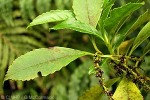Cook Islands Biodiversity Database
Species Page
Ascarina diffusa
Kaiatea Ko‘u*Ascarina
Multimedia & Additional Resources
| Type | Description | Download |
| Leaves and fruits | 82KB | |
| Leaves, female flowers and fruit | 41KB |
General Information
Cook Islands Distribution
| Southern Group: Present Makatea: - | ||||||||
RR |
MG |
AT |
MK |
MT |
AK |
PL |
TK |
MN |
+++ |
- |
- |
- |
- |
- |
- |
- |
|
| Northern Group: - | |||||
TN |
MH |
RK |
PK |
NS |
SW |
- |
- |
- |
- |
- |
- |
Scientific Taxonomy
Ascarina diffusa A.C. Sm.
SYNONYMS: Ascarina lanceolata [sensu TC/GW]
TAXONOMY: PLANTAE; ANTHOPHYTA (=Angiospermae); MAGNOLIOPSIDA (=Dicotyledones); MAGNOLIIDAE; Piperales; CHLORANTHACEAE
More Information
SIGNIFICANCE NOTES -. Comments: MATERIAL: Good hardwood timber, yellowish with darker grain.
IDENTIFICATION: A small sprawling tree to 12m. LEAVES opposite and alternate; light-green, glossy, with fine lacy veins; narrow-oval, to 15x5cm; tip sharp, edge toothed; stalk 5-25mm. FLOWERS on pendent spikes; each minute, without petals; plants usually unisexual, sometimes male and female flowers adjacent ("pseudo-bisexual flowers"). FRUIT very small, oval, 3x2mm, ripening red-brown. SEED one.
GENERAL NOTE: For the scientifically underchallenged. A monoecious plant has bisexual flowers or unisexual flowers of both gender, while a dioecious plant has unisexual flowers of one gender only.
For Ascarina it is thought that the primitive condition was 1 male flower and 1 female flower in a cluster, called a Glomerule. A glomerule is not a bisexual flower, but a 'pseudo-bisexual flower', and a plant of this type is monoecious having both genders present. During flower development flowers of one gender are usually removed, leaving the plant as dioecious having unisexual flowers of one gender only. However, for our species, some male-female clusters remain making it monoecious, although it can at first seem to be dioecious. [adapted from Smith, Fiji Flora].
Vouchers & References
Vouchers:
None Recorded.
References:
p.2/099 A.C.Smith - Flora Vitiensis Nova
p.293 I Cheeseman - Flora of Rarotonga
p.39 Wilder - Flora of Rarotonga
p.416 Whistler - Ethnobotany of the Cook Islands
p.125 McCormack/Kunzle - Rarotonga's Mountain Tracks and Plants
Data Update History (information):
zTX, zB02, zM02, zupM04b, zD02
Web Resources
Citation Information
McCormack, Gerald (2007) Cook Islands Biodiversity Database, Version 2007.2. Cook Islands Natural Heritage Trust, Rarotonga. Online at http://cookislands.bishopmuseum.org. ![]()
Please refer to our use policy.

